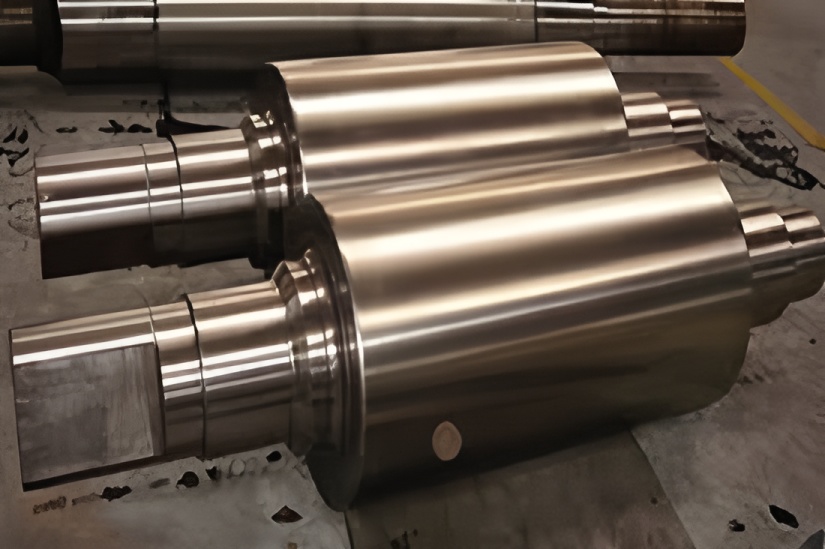What are the commonly used materials for roll manufacturing and how are they classified?
The Chinese national standard GB/T13314 General Technical Conditions for Forged Steel Cold-Rolled Work Rolls lists seven common materials for cold-rolled rolls. Through long-term development, Chinese roll manufacturers have established a new material series. These materials are typically classified by chromium content:
2% Cr series: includes 9Cr2, 9Cr2Mo, 9Cr2MoV, etc.
3% Cr series: such as 9Cr3Mo and MC3
5% Cr series: including MC5, MC5A
Special materials like high-speed steel, semi-high-speed steel, and high-alloy tool steel are also used.
What are the characteristics of commonly used roll materials?
Cold roll materials must meet demanding working conditions. They require:
High strength to withstand heavy surface loads
High wear resistance due to friction with rolled material and backup rolls
High accident resistance for rolling incidents
Good texturing properties, corrosion resistance, and grindability
How to select roll material?
Material selection depends on mill design and operating conditions. Common materials generally meet basic requirements. Key considerations include:
Maximum use depth: 2% Cr offers 15–20mm effective hardened depth; 3% Cr reaches 20–30mm; 5% Cr achieves 20–50mm with suitable quenching
Rolling conditions and product requirements: 2% Cr is recommended for better accident resistance during mill run-in; 3% or 5% Cr offer better hardness uniformity for high-demand sheet rolling
Classification and Material Selection of Metallurgical Mill Rolls
What are the smelting processes for cold roll materials?
Cold rolls are typically made from medium-high alloy high-carbon chromium steel. Due to heavy load and high fatigue conditions, smelting requires:
Electric arc furnace (EAF) melting to achieve target chemistry and control harmful elements
Often followed by external refining to adjust composition and reduce gas content
What heat treatments are involved in manufacturing forged steel cold rolls?
Multiple heat treatments are applied:
Diffusion annealing after casting to reduce segregation
Spheroidizing and dehydrogenation annealing after forging to improve carbide distribution and reduce gas content
Quenching and tempering after rough machining to enhance core mechanical properties and prepare for final treatment
Body quenching: whole or surface heating above austenitizing temperature, followed by rapid cooling to form a high-hardness martensite layer, and low-temperature tempering to adjust hardness and relieve stress
Additional local heat treatment may be applied to the bearing journal
What is cold treatment and what is its purpose?
Cold treatment involves placing the quenched (before tempering) forged steel roll into a -40°C to -120°C cryogenic tank. This process enhances transformation stability and reduces retained austenite.
How is the final heat treatment of the roll body performed?
Final heat treatment usually refers to body quenching. Common methods include:
Overall heating: Heating the entire roll in a furnace to austenitizing temperature, then rapid cooling. This method is simple but may cause deformation, high stress, or cracking.
Surface heating (e.g., induction quenching): Using low/medium frequency, power frequency, or dual-frequency induction heating. This allows rapid, controlled surface heating with minimal distortion and optimized stress distribution.
What are the typical technical requirements for cold rolled work rolls?
Requirements vary by mill. General strip mill work rolls typically require:
Body hardness uniformity: 2–3 HS
Radial hardened depth: ≥15 mm
Microstructure: martensite + finely dispersed carbides + retained austenite
Uniform carbide distribution; network rating ≤2.5
Retained austenite in hardened layer: ≤15%
Soft band width: ≤60 mm
What is the manufacturing process for forged steel cold rolled work rolls?
Processes vary based on working conditions and manufacturer methods. A typical process includes:
Product design → Smelting (EAF, EAF + LFV) → Pre-casting inspection → Protective casting electrode → Electrode annealing → Electrode cleaning → ESR ingot casting → High-temperature diffusion → Forging (normalizing) → Spheroidizing & dehydrogenation annealing →
Rough turning (cut test sample) → Inspection (UT, macro/micro, dimensions, appearance) → Storage →
Pick-up → Rough machining → UT inspection → Quenching and tempering → Hardness test → Semi-finishing → Journal and thrust face quenching/tempering → Journal hardness test → Semi-finishing → UT inspection → Body surface quenching (+ cold treatment + low tempering) → Body hardness inspection → Finishing → Inspection → Storage → Rust prevention, packaging, and shipping.
What is the function of each alloying element in cold roll material?
In 86CrMoV7 work rolls:
C (Carbon): strengthens the matrix through solid solution and forms carbides to enhance wear resistance.
Cr (Chromium): improves hardenability, strength, and corrosion resistance; forms M₃C or M₇C₃ carbides to increase wear resistance.
Mo (Molybdenum): enhances hardenability and strength, reduces temper brittleness.
V (Vanadium): refines grain structure, increases hardenability and strength, and improves toughness and plasticity.


